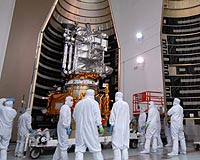 |
Bangalore, India (SPX) May 22, 2009 The Indian space agency has raised the orbit of its first unmanned lunar spacecraft Chandrayaan-1 to 200km from the lunar surface for further studies on orbit perturbations and gravitational field variations of the Moon. 'With the successful completion of all the mission objectives from 100 km above the moon since November 2008, we have raised the height of the spacecraft to 200 km Tuesday to enable imaging lunar surface with a wider swath,' the Indian Space Research Organisation (ISRO) said in a statement here Wednesday. During the last seven months, all the 11 scientific payloads onboard the 519kg Chandrayaan-1 spacecraft have been operationalised and excellent quality data has been received. 'The scientific community from India and other participating international agencies are analysing the data and several interesting results have been obtained,' the statement said.
Moments before the Moon mission launch 'The scientific data from Chandrayaan-1 is being archived and disseminated from the Indian space science data centre, which is also located at Byalalu,' the statement added. Of the 11 scientific instruments (payloads), five are Indian and six foreign, including three from the European Space Agency (ESA), two from the US National Aeronautics and Space Administration (NASA) of the US and one from Bulgaria. The scientific objectives of the spacecraft are remote sensing of the Moon in visible, near infra-red, low energy x-ray and high-energy x-ray regions.
Chandrayaan I launched successfully 'Specific instruments will conduct chemical and mineralogical mapping of the entire lunar surface for collecting data on the distribution of elements such as magnesium, aluminium, silicon, calcium, iron and titanium, with a spatial resolution of about 25km and high atomic number elements such as radon, uranium and thorium, with a spatial resolution of about 20km,' a senior space scientist told IANS. Of the five Indian payloads, the 34kg moon impact probe (MIP) was crashed onto the lunar surface November 14. During the probe's 25-minute descent, its mass spectrometer measured the constituents of the thin lunar atmosphere. The spectrometer also analysed the chemicals and minerals of the moon and relayed the data to the ground station after impacting the lunar surface. The probe, carrying three instruments and with the Indian flag painted on its outer panes, settled in a crater in the Moon's South Pole. Share This Article With Planet Earth
Related Links ISRO Mars News and Information at MarsDaily.com Lunar Dreams and more
 NASA Details Plans For Lunar Exploration Robotic Missions
NASA Details Plans For Lunar Exploration Robotic MissionsWashiongton DC (SPX) May 22, 2009 NASA's return to the moon will get a boost in June with the launch of two satellites that will return a wealth of data about Earth's nearest neighbor. On Thursday, the agency outlined the upcoming missions of the Lunar Reconnaissance Orbiter, or LRO, and the Lunar Crater Observation and Sensing Satellite, or LCROSS. The spacecraft will launch together June 17 aboard an Atlas V rocket from ... read more |
|
| The content herein, unless otherwise known to be public domain, are Copyright 1995-2009 - SpaceDaily. AFP and UPI Wire Stories are copyright Agence France-Presse and United Press International. ESA Portal Reports are copyright European Space Agency. All NASA sourced material is public domain. Additional copyrights may apply in whole or part to other bona fide parties. Advertising does not imply endorsement,agreement or approval of any opinions, statements or information provided by SpaceDaily on any Web page published or hosted by SpaceDaily. Privacy Statement |